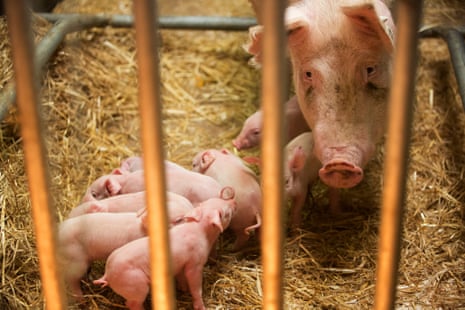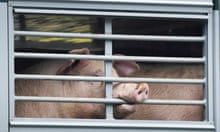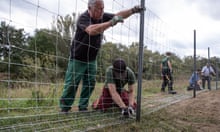On an isolated farm outside Edinburgh, pigs grunt eagerly as their food arrives. The barn has a typical farmyard whiff, and a litter of tiny piglets, born just hours earlier, lie with trotters outstretched and eyes sealed, as helpless as any newborns. Only the occasional fluorescent snout or trotter reveals that the building is home to one of the world’s most advanced genetic modification projects.
“These are happy animals. They have a lovely sheen on them, their tails are wagging away,” said Prof Bruce Whitelaw, head of developmental biology at the University of Edinburgh’s Roslin Institute, which is responsible for the pigs.
Prof Whitelaw believes the newborn piglets, which are designed to be resistant to the disease African swine fever, could be among the first commercially viable GM animals to have been created in Britain. The piglets are indistinguishable from other Large White variety pigs – except one letter of their genetic code has been flipped to make their immune system slightly closer to a warthog’s.
Within weeks, the piglets will be transported to a high security laboratory in Surrey where they will enter a trial to see if this modification protects them against the tick-borne disease, which is currently sweeping through eastern Europe and could affect British farms in the future.
“We need these animals to deliver something that could be a product,” said Whitelaw. “If these pigs show resilience, we will go to the regulators. The limitations are no longer technical, they’re legal.”
The African swine fever-resistant pigs live alongside others engineered to have enhanced immunity to swine flu (the fluorescent ones), and the pig respiratory disease, PRRS. Whitelaw believes that such animals could be commercially available within five to 10 years.
The breakthrough, he said, has been the development of new “ultra precise” gene editing tools that introduce changes in a way that is indistinguishable from naturally occurring mutations. The new techniques also overcome three major objections to GM in the past: the use of viruses to “carry” genetic changes into the pigs’ cells, the need to use antibiotic resistance genes in the modification process, which has been seen as an environmental threat, and the need for cloning.
“There are no markers, no vectors,” said Whitelaw. “People are absolutely not going to want to eat animals with fluorescent snouts.”
The welfare aspect of creating disease resistant animals may also prove more acceptable to the public than simply trying to create bigger, meatier farm animals, he argues.
“We’re not trying to make huge pigs, we’re trying to make healthier ones,” he said. “I’d be staggered if anyone said ‘No, I don’t want my animal to be healthier’.”
Farmers have also welcomed the focus on disease resistance, because unlike size and fertility, resilience to new diseases is almost impossible to breed in using traditional methods.
At a recent industry talk Whitelaw gave on the African swine fever trial, the first question, from a Lithuanian farmer was “When can I get these animals?” he said. “Farmers are ready.”
This month, around 6,000 pigs are expected to be culled in Poland, after outbreaks on farms, and the disease is known to have spread to neighbouring countries.
The trial, due to begin later this summer at either the Pirbright Institute or the Animal Health and Veterinary Laboratories Agency in Weybridge, will involve exposing 12 “edited” pigs and 12 normal animals to the virus and testing mortality and transmission rates in the two groups to assess whether the modified pigs fare better.
The gene-editing technique works by taking a fertilised egg and using molecular scissors to snip the pig genome at the target site – in this case an immune gene called RELA. The cell’s natural repair process introduces a minor error, making the gene slightly less active than the normal version, producing a gentler immune response closer to that seen in warthogs. Scientists think this should confer resistance to African swine fever, because the disease causes the pig immune system to go into overdrive. “The immune system grossly overreacts to something that itself isn’t that harmful,” said Simon Lillico, a senior researcher at Roslin. “Warthogs still get infected, they just don’t drop dead.”
The scientists have also created pigs with the exact warthog version of the gene and the first three of these pigs are now entering a breeding programme ahead of a second trial due to begin next year.
By contrast, conventional GM techniques start by taking skin cells from an animal. These are then modified, but because the modifications are successful in only a small fraction of cells, scientists include an antibiotic resistant gene tag that allows them to weed unsuccessful cells with drugs.
The nucleus of the modified skin cell is then inserted into an egg, which is grown in culture and transplanted into a “foster” animal to produce a modified clone, but many cloning pregnancies fail.
Other previous genetic modification experiments have involved using viruses to insert genetic changes into cells at a random location on the genome, but this risks so-called “off target” effects.
If the African swine fever trial is a success – the scientists will know the results by autumn – they are likely to apply to the US Food and Drug Administration for commercial approval.
While the FDA has approved several GM crops, until now it has stopped short of declaring farm animals created using the technology safe to eat. A GM salmon designed to grow twice as fast as normal fish could be the first to be approved.
Elsewhere, other GM animals being developed include “double muscled” pigs, designed to be larger than normal, cows that produce milk without beta-lactoglobulin, which causes allergies and dairy cows that do not grow horns, which can cause injuries.










Comments (…)
Sign in or create your Guardian account to join the discussion